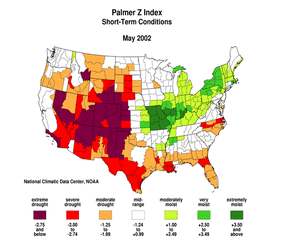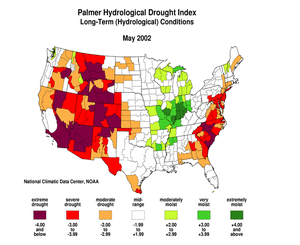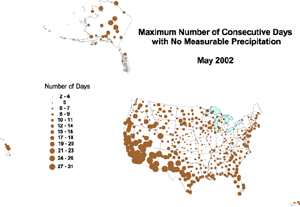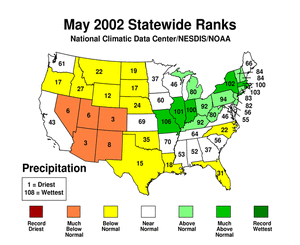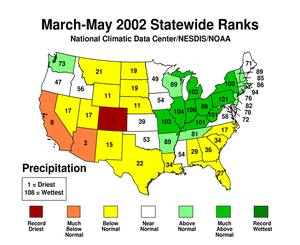National Overview
On the national scale,
|
 |
 |
| Although some areas of the U.S. had above normal precipitation, many areas were very dry. Integrated across the nation, May 2002 precipitation averaged below normal. Twelve of the last 33 months have averaged well below the normal, while only three averaged well above normal (see graph top right). National 2001-2002 precipitation ranks:
|
 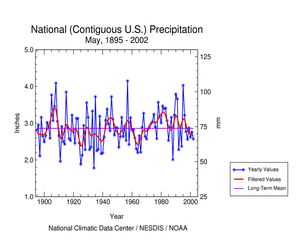 |
Regional Overview
|
May was very dry across much of the western U.S. and adjoining Great Plains, the Gulf Coast, and parts of the mid-Atlantic states. Near-normal precipitation fell across part of the Pacific Northwest, mainly Washington and the extreme northern Rockies.
Beneficial rains continued for a third month bringing drought relief to a good part of the Northeast.
May was wet at the primary stations in Hawaii, dry at many stations in Puerto Rico, and showed a mixed pattern across Alaska.
These overall conditions are evident in the following indicators:
Two other drought-related monitoring tools are the Vegetation Health Index and the Keetch-Byram Drought Index:
|
Western U.S. Drought
|
While beneficial rain and snow fell across part of the Pacific Northwest, mainly Washington and the extreme northern Rockies, short-term drought characterized the conditions across much of the western U.S. during May. Water year (October 2001-present) precipitation totals were above average in the northwest, but totals dropped precipitously toward the Rockies and the Southwest. Snowpacks were essentially melted for this water year except for the higher elevations of the northern Rockies, northern Cascades, and Canada.
A detailed discussion of drought conditions in the western U.S. can be found for the following regions:
Dry conditions in the western U.S. stretched from the Canadian border to the Mexican border. As illustrated in the North America vegetation health index map to the right below, the drought did not stop at the borders. According to news reports (Reuters), |
|
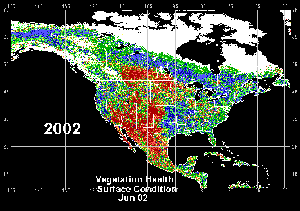 |
| The drought in the western U.S. extended into the adjoining portions of the Great Plains. The precipitation deficits across this entire region, stretching from the High Plains to the West Coast, have ranked in the top ten driest category (out of 107-108 years) for all seasons from May back to June-May (see table below). The deficits have persisted, in some cases, for three years (see table, and top graph below right). This region experienced a rapid intensification of the Palmer Hydrological Drought Index (PHDI) in 2000 (see bottom graph below right), which was compounded by numerous wildfires that summer. The regional PHDI has reached levels this May comparable to those of summer 2000. |
|
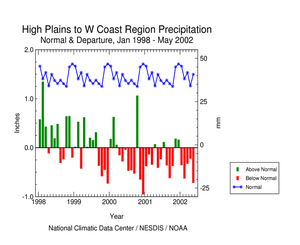 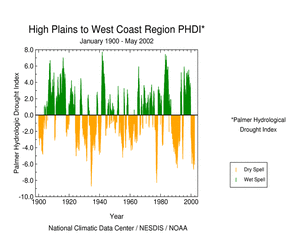 |
Central U.S. Drought
| May 2002 was unusually dry across much of the central U.S., from the High Plains of Montana and the Dakotas to southern Texas. This month was a continuation of dryness which extended back for a year or longer for some of these areas. |
| The West North Central region, which consists of the western states Montana and Wyoming and the Great Plains states North and South Dakota and Nebraska, has had six consecutive months of near to below-normal precipitation (see top graph below). Dryness during most of the last ten months has given the region a rank of second driest August-May (see bottom graph below). |
|
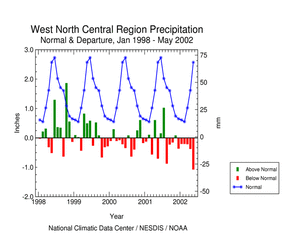 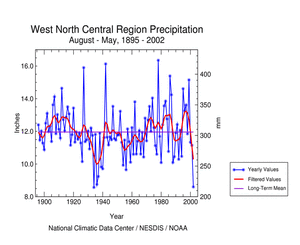 |
Some Montana drought impacts:
|
May marked the second consecutive dry month, regionwide, for the South region. There has been considerable variability within this region, with the western and southern portions of the South region being hardest hit by drought (see map to right for short-term soil moisture conditions). Some drought impacts:
|
 |
|
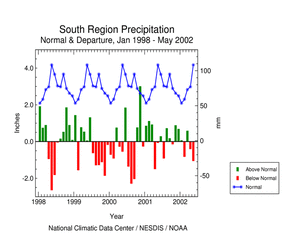 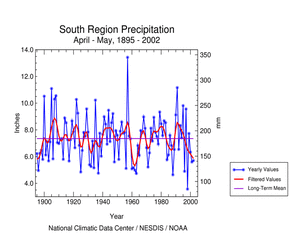 |
Eastern U.S. Drought
| May marked the third consecutive wet month across much of the Northeast region, bringing drought relief to much of the area. However, long-term deficits remain, with June 2001-May 2002 ranking as the 21st driest June-May on record. In the Southeast, this was the second consecutive month with dry conditions averaged across the region. May dryness was especially acute across the Gulf coast and in North Carolina. |
|
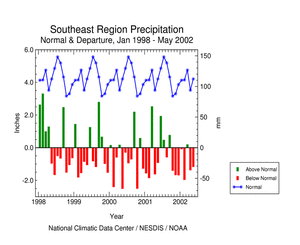 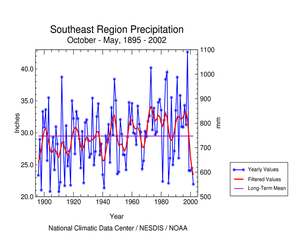 |
Pacific Northwest
The southern parts of the Pacific Northwest (mainly Oregon and southern Idaho) were dry during May, giving the region a rank of 28th driest May (see table and graphic below).
On balance, however, the 2001-2002 wet season ranked near the middle of the historical distribution for the region as a whole (see table below). |
|
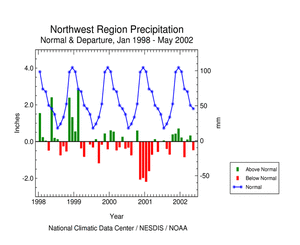 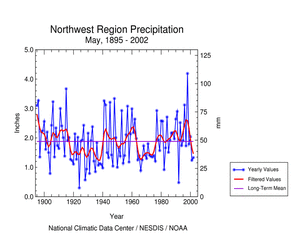 |
West Region (CA-NV)
|
The 2001-2002 wet season started out wet for the West region. The weather turned drier than normal in January, with May 2002 marking the fifth consecutive month with below-normal precipitation regionwide (see top graphic below right). January-May 2002 ranked as the seventh driest January-May in the 108-year record (see bottom graphic below right).
The Southwest and southern California are ripe for the riskiest fire season ever, said Edy Williams-Rhodes, fire management director for the Forest Service's southwestern region (NBC News). |
|
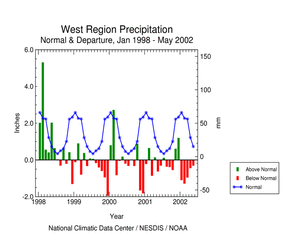 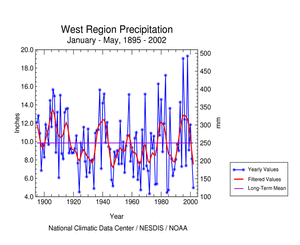 |
Southwest Region
| May 2002 marked the twelfth consecutive month with near to much below normal precipitation for the Southwest region (see top graph below right). This has resulted in the driest or second driest month or season for each of the twelve periods from May back to June-May (see table below) and caused the regional Palmer Hydrological Drought Index to plummet, reaching levels comparable to the worst drought episodes of the last 100 years (see bottom graph below right). |
|
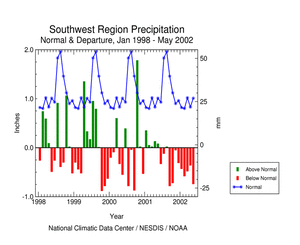 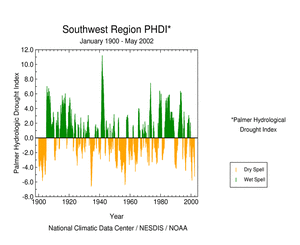 |
The drought has had significant impacts across the region:
|
 Wildfires
Wildfires
Numerous wildfires occurred during May, with the possibility of a very active wildfire season for summer 2002. Some highlights:
|
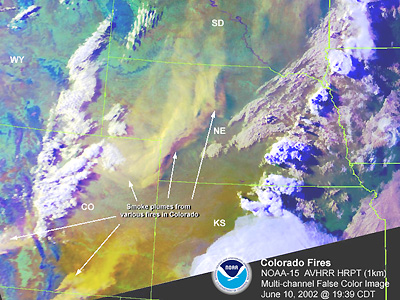 |
The picture to the left was prepared by the National Climatic Data Center from visible satellite imagery and shows smoke plumes from the fires in Colorado on June 10. Additional satellite pictures of the Colorado fires are available from the Space Science and Engineering Center at the University of Wisconsin-Madison. |
|
Wildfires result from a combination of weather factors including low precipitation which parches the vegetation and soil, low humidity, and a trigger mechanism such as dry lightning storms or campfires. Hot, windy weather helps to fan the flames.
The Standardized Precipitation Index (SPI) and Palmer Z Index are used as measures of short-term drought. Research by Tom Karl (1986) suggests that the Z Index may be a useful indicator of fire potential. The SPI (see maps to right) illustrate the magnitude of the dryness over the Southwest during May and spring. The Z Index map (below) shows the combination of hot and dry weather during May. |
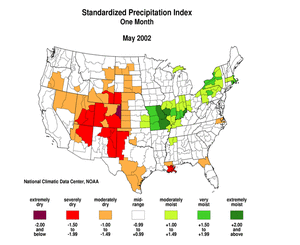 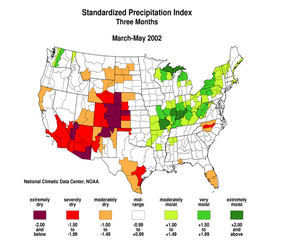 |
|
Reference:
Karl, T.R., 1986. "The sensitivity of the Palmer Drought Severity Index and Palmer's Z-Index to their calibration coefficients including potential evapotranspiration." Journal of Climate and Applied Meteorology, 25:77-86. |
 Paleoclimatic Record
Paleoclimatic Record
| NOAA's Paleoclimatology Program utilizes data from sources other than instrumental weather records (what are called proxy data which include, for example, tree rings, ice cores, and pollen analysis) to understand and model interannual to century-scale environmental variability. Proxy data have been used to reconstruct drought indices going back several hundred years to provide a long-term perspective on drought variability, particularly when it comes to multi-decadal droughts that have occurred prior to comprehensive instrumented records. Such an expanded view provides insight into what a "normal" climatic range is for a region. |
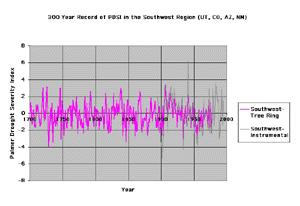 |
The graph to the left is a 300-year record of the June-August Palmer Drought Severity Index reconstructed using tree ring data for the Southwest region (the methodology is discussed in an article by Cook et al., 1999; details are also available at the NOAA Paleoclimate web site). The tree ring data successfully reproduce the droughts of the early 1900's, 1930's, and 1950's, although due to its nature it is a conservative index of severity. The reconstructed index shows that droughts as severe as the worst during the 20th century have occurred many times during the past 300 years. In fact, the most severe drought in the tree ring-based index occurred during the first half of the 1700's. |
| The graph to the right shows the April 1 snow water equivalent (SWE) for the Gunnison River Basin in Colorado, reconstructed from tree rings, for the 1569-1999 period (an article by Woodhouse discusses details; similar research is described at the NOAA Paleoclimate web site). The values are expressed as a percentage of the 1971-1999 average. The SWE for April 1, 2002, was about 50% (not shown on graph). In the instrumental record for this basin (1938-2002), 1977 was the only year besides 2002 at 50% or less than the average. In the 431-year reconstruction, only four years (1598, 1654, 1851, and 1977) were at 50% or less than the 1971-1999 average. |
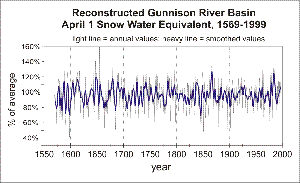 |
|
References:
Cook, E.R., Meko, D.M., Stahle, D.W. and Cleaveland, M.K. 1999. "Drought reconstructions for the continental United States." Journal of Climate, 12:1145-1162. Woodhouse, C.A. In review. "A 431-year reconstruction of western Colorado snowpack." Journal of Climate. |
 Colorado Drought
Colorado Drought
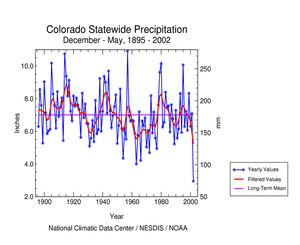 |
In Colorado, May marked the sixth consecutive month with below to much below normal precipitation statewide (see top graph below right). The deficits have been so severe that previous dry records have not been just broken, they have been shattered (see December-May graph to left). The persistent extreme short-term dryness, month after month, has resulted in the statewide long-term Palmer Hydrological Drought Index reaching levels more severe than the droughts of the 1950's and 1960's (see bottom graph below right). It should be noted that previous severe droughts have lasted much longer than the current drought. |
|
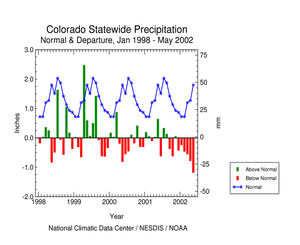 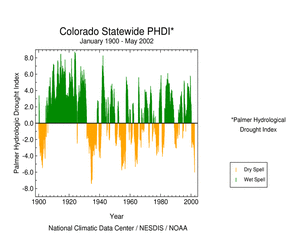 |
The drought in Colorado brought an early start to the fire season and has severely impacted agriculture (Boulder Daily Camera). According to media reports:
|
 Arizona Drought
Arizona Drought
| In Arizona, May marked the 13th consecutive month with near to much below normal precipitation statewide (see top graph below right). The persistent extreme short-term dryness, month after month, has resulted in the statewide long-term Palmer Hydrological Drought Index reaching levels as severe as the droughts of the last 90 years (see bottom graph below right). As with Colorado, some previous severe droughts in Arizona have lasted much longer than the current drought. |
|
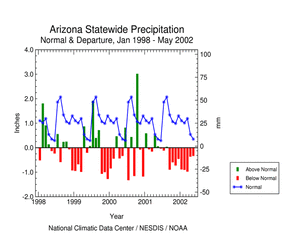 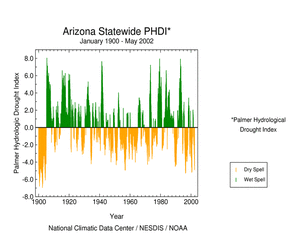 |
The drought has had significant impacts on parts of Arizona. Some highlights:
|
Alaska Dryness
May 2002 continued a pattern of below-normal precipitation for much of coastal southern Alaska and the Alaska panhandle.
As noted by the National Weather Service office in Juneau, dry conditions this spring in Alaska have begun to produce adverse effects:
As noted by media reports, hot, dry, windy weather near the end of May fanned numerous forest fires across parts of the state. By early June, the year-to-date (January 1-June 4) acreage burned exceeded 400,000 acres, which is 26 times the average and three and a half times the total acres for the same time of year for the previous 7 years combined (BLM - Alaska Fire Service). The drought code used by the Alaska Fire Service had moderately dry conditions extending from the southern coast into east central Alaska, with a high risk of wildfires in early June extending across the interior portions of the state. |
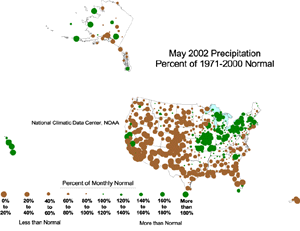 |
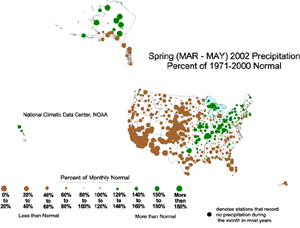 |
| The May and spring dryness in southern coastal Alaska and the panhandle are evident in the percent of normal precipitation maps (above) and in the departure from normal number of days with measurable precipitation (map below left), and to a lesser degree in the maximum number of consecutive days with no measurable precipitation map (below right). |
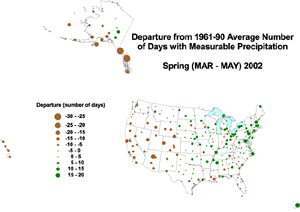 |
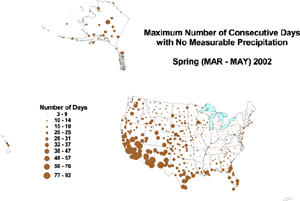 |
Damage due to the drought has been summarized by NOAA and the Office of Global Programs in the Climatological Impacts section of the Climate Information Project. Crop impact information can be found at the USDA NASS (National Agricultural Statistics Service) and Weekly Weather and Crop Bulletin pages. Drought statements by local National Weather Service Offices can be found at the NWS Hydrologic Information Center. Drought threat assessments and other information can be found at NOAA's Drought Information Center. Additional drought information can be found at the National Drought Mitigation Center, the USDA's National Agricultural Library, the interim National Drought Council, and the NOAA Paleoclimatology Program. The following states have set up web pages detailing current drought conditions and/or their plans to handle drought emergencies:
For additional information on current and past wildfire seasons please see the National Interagency Fire Center web site or the U.S. Forest Service Fire and Aviation web site. NCDC's Drought Recovery Page shows the precipitation required to end or ameliorate droughts and the probability of receiving the required precipitation. Additional climate monitoring graphics can be found at the Climate Prediction Center's monitoring pages:
Drought conditions on the Canadian prairies can be found at the Agriculture and Agri-Food Canada Drought Watch page. |
 NOAA's National Centers for Environmental Information
NOAA's National Centers for Environmental Information
